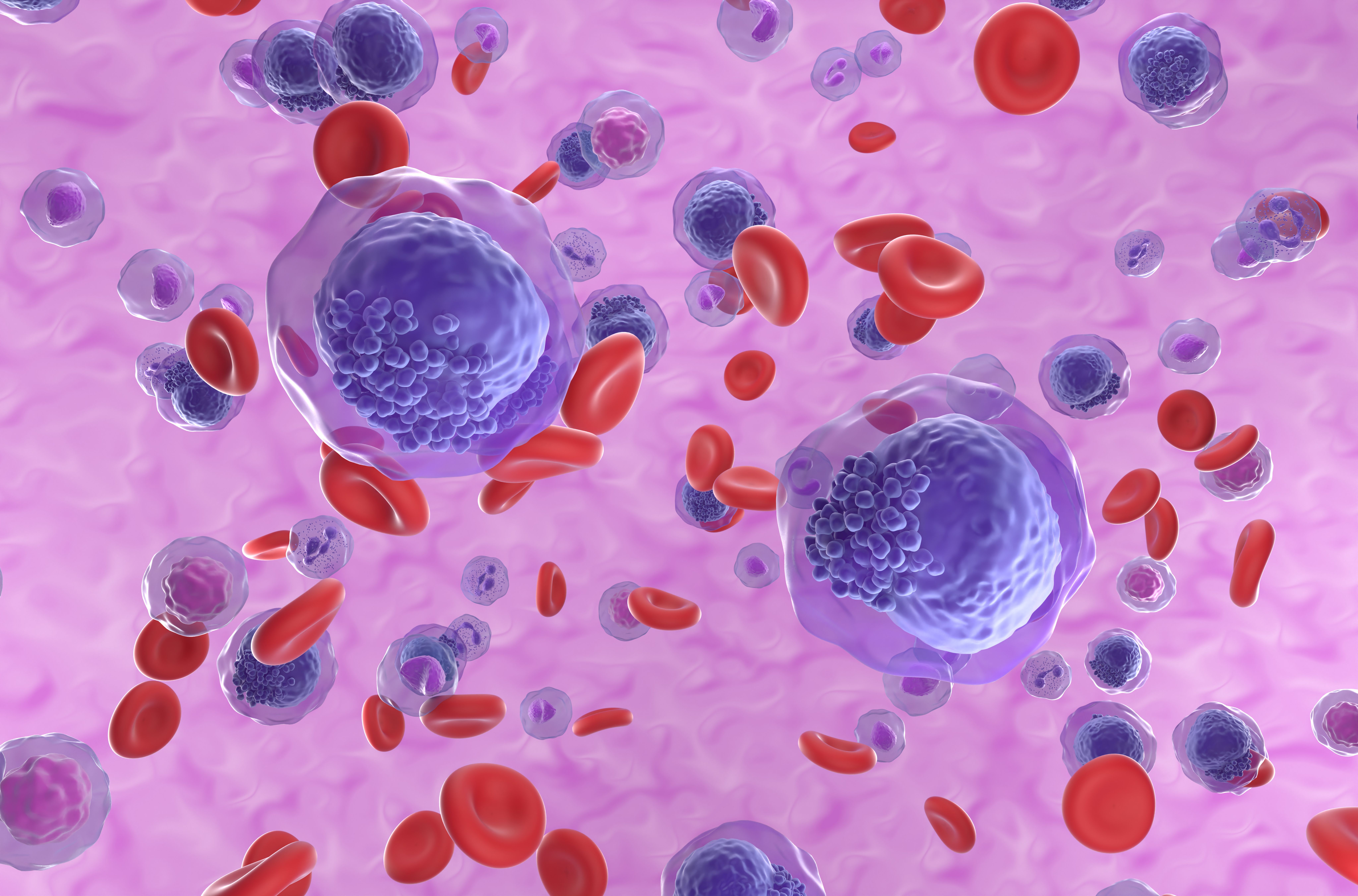New Combination Shows Strong Responses in Phase 2a Portion of AML Trial
A phase 1/2 trial showed that SLS009 in combination with azacitidine and venetoclax achieved a 50% response rate in relapsed/refractory acute myeloid leukemia.
acute myeloid leukemia AML: © LASZLO - stock.adobe.com

Positive topline findings from the phase 2a portion of a phase 1/2 trial (NCT04588922) evaluating SLS009 (formerly GFH009) showed that at the March 15, 2024, data cutoff date, SLS009 combined with azacitidine and venetoclax (Venclexta) demonstrated an overall response rate (ORR) of 50% in patients with relapsed/refractory acute myeloid leukemia (AML) who received the agent at the selected optimal dose of 30 mg twice weekly, exceeding the targeted 20% rate.1
At the same time, SELLAS Life Sciences Group, Inc. announced that the phase 3 REGAL trial (NCT04229979) studying galinpepimut-S (GPS) for the treatment of patients with AML has completed enrollment. An interim analysis guided by the REGAL trial’s steering committee is expected to begin soon.
“We are extremely excited to share positive topline data from the phase 2a trial of SLS009 in [patients with] AML resistant to venetoclax combination therapies,” said Angelos Stergiou, MD, ScD, hc, president and CEO of Sellas, in a press release. “These compelling results from the phase 2a [portion of the trial] reinforce our belief that SLS009 represents a potential breakthrough for [patients with] relapsed and/or refractory AML, addressing 1 of the most urgent unmet medical needs.”
About the Phase 1/2 Trial of SLS009
SLS009 is being studied in an open-label, single-arm, multicenter trial. Investigators evaluated the safety, tolerability, and efficacy of SLS009 when given in combination with azacitidine and venetoclax in patients with AML that was relapsed/refractory to venetoclax-containing regimens.2
The primary end points being explored are safety and tolerability, including incidence of dose-limiting toxicities (DLTs) and severity of all adverse effects. Pharmacokinetics, complete response (CR), duration of response, progression-free survival, and overall survival (OS) are key secondary end points of the study. Further, investigators are working to identify biomarkers in this patient population.
A total of 21 patients were enrolled in the trial, including 10 treated with SLS009 at 45 mg once weekly in a safety cohort, and 11 who were given SLS009 at either 30 mg twice weekly or 60 mg once weekly.1 Among those enrolled, 95% of patients had adverse or high-risk cytogenetics, 5% had intermediate cytogenetics, and the median age of patients was 70 years. Further, 90.5% of those included in the study were older than 60.
Additional findings from the study showed that among those in the 45 mg cohort, the ORR was 10%. This dose level was determined to be below the recommended phase 2 dose for use in the study. In the 60 mg once a week cohort, the ORR was 20%.
The median OS with SLS009 was not yet reached at any dose level, and the target median OS is over 3 months. There was strong antileukemic activity observed with the agent, defined as bone marrow blast reduction of at least 50%. This was seen in approximately 67% of patients across all dose levels. The first patient enrolled in the study who achieved a CR remains on the study and is still leukemia-free 9 months post enrollment.
Looking at safety, the agent demonstrated a favorable safety profile across all dose levels. No DLTs were observed at any of the dose levels. There were also no treatment-related toxicities deemed grade 3 or greater observed.
During the study, all patients with identified potential predictive biomarkers who received the SLS009 at the optimal dose level responded.
“Notably, we identified promising biomarkers and observed a 100% response rate at the optimal dose level and a 57% response rate across all the levels tested in patients with those biomarkers,” added Stergiou in the press release.
Sellas has clarified the proposed biological basis and mechanism of action for SLS009 in patients with these biomarkers, who may also benefit from this treatment due to the presence of these biomarkers in other cancer indications, including several hematologic and solid cancers.
About SLS009 and the REGAL Trial
In 2024, the FDA granted a fast track designation to the novel CDK9 inhibitor for the treatment of relapsed/refractory AML. SLS009 was granted an orphan drug designation in October 2023 for the same indication.
The REGAL trial's steering committee met on March 22, 2024, to discuss the study. They noted that the interim analysis, requiring 60 events, may begin soon due to the high number of patients who completed trial participation.1
As of the March 1, 2024, data cutoff, 123 patients had been enrolled in the trial. Sixty-six patients discontinued the study treatment due to relapse, intolerable toxicity, death from any cause, or treatment completion.
“Completion of enrollment in the phase 3 REGAL trial represents an important milestone in our goal to deliver GPS to [patients with] AML,” added Stergiou in the press release.
REFERENCES:
1. Sellas announces positive topline data from the phase 2a study of SLS009 in r/r AML and provides steering committee update on phase 3 REGAL study. News release. Sellas Life Sciences Group, Inc. March 26, 2024. Accessed March 27, 2024. https://tinyurl.com/3r6bjjhf
2. A study of GFH009 in patients with hematologic malignancies. ClinicalTrials.gov. Updated September 1, 2023. Accessed March 27, 2024. https://classic.clinicaltrials.gov/ct2/show/NCT04588922
FDA Clears Phase 1 Study of Lomonitinib for R/R AML Treatment in the US
June 10th 2024An investigational new drug application for lomonitinib has been cleared by the FDA for FLT3-mutated relapsed/refractory AML treatment, and a phase 1 trial evaluating the agent will begin in the US.
Read More